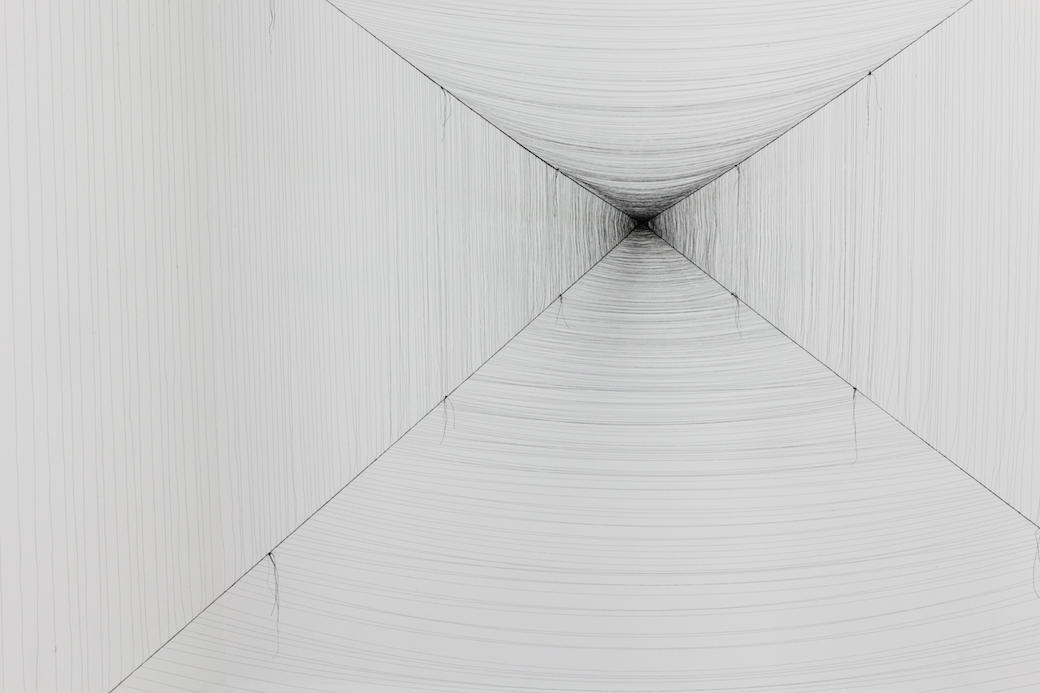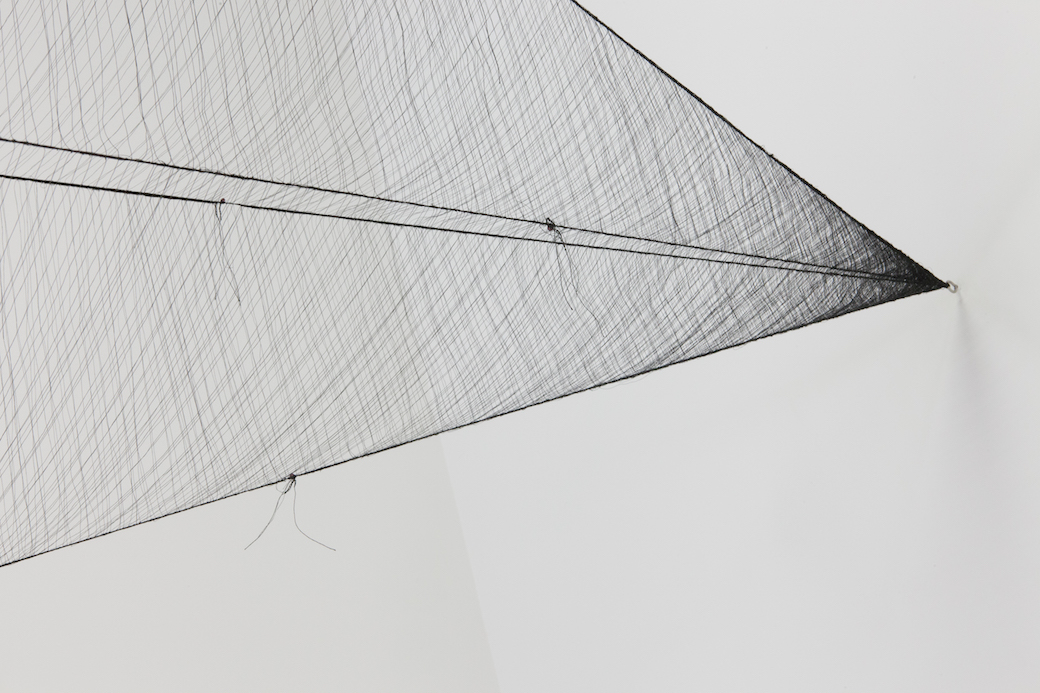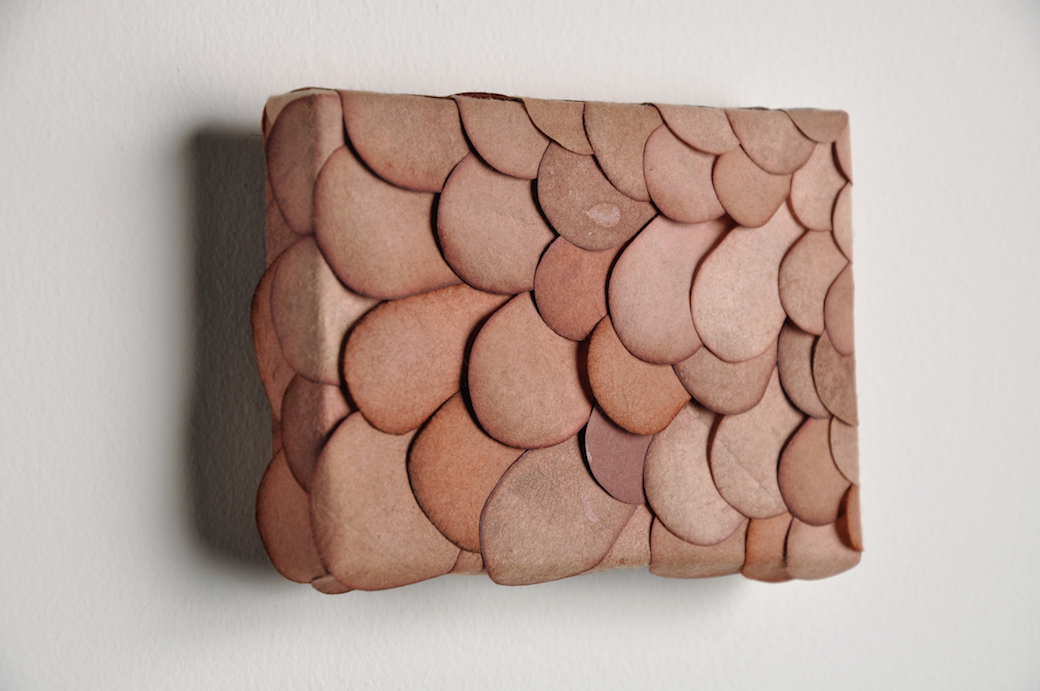
Vanessa Brook Williams. Untitled, 2012-2014. Thread, eye screws. Installation detail. Exhibited as part of MINT Gallery’s Leap Year Fellowship in 2014. Photo by Margaret Hiden. Courtesy of the artist. © 2016.
Suspended like an enormous spider web, Vanessa Brook Williams’ stunning installation, Untitled (2012–14), makes the invisible palpable and reveals the uncertainty of our perceptions. The work, made entirely of thread, fills an all-white room inside a private warehouse on the outskirts of Atlanta. Using simple materials like thread, paper, beads, glue, charcoal, and dye, Williams employs minimalist sculptural strategies to “reveal the intellectual space we inhabit.”1
An emerging artist working in Atlanta, Williams is preoccupied with how best to communicate experiences such as the sweep of space between the human body and the ocean horizon, or the reach of the sun on one’s face. She identifies the horizon as “the representation of time that is our orientation to space.” Spatial and temporal experiences, evocative of the sublime, inhabit her thoughts as she conceives and meticulously plans her sculptures and installations.

Vanessa Brook Williams. Untitled, 2012-2014. Thread, eye screws. Installation detail. Exhibited as part of MINT Gallery’s Leap Year Fellowship in 2014. Photo by Margaret Hiden. Courtesy of the artist. © 2016.
Untitled begins with a 10 foot wide-by-8-foot high rectangle outlined in thread, floating close to the wall. This shape is followed by many successively smaller ones as the work progresses toward the end of the room. Suspended on an armature of crocheted thread, anchored with four eye screws, the work creates a three-dimensional form receding in space. The structure activates the fullness of the room and makes viewers aware of the space we share. It presents a perceptual conundrum, shimmering between the real and the surreal. With this barely-there installation, Williams brings us closer to a materialization of time and space.
Williams explained, “Time and physical space: we don’t have a tangible, accurate way to express them.” To give form to these intangibles, she spent two years conceptualizing, researching, assembling materials, testing, and constructing Untitled. To her small sculptures, she applies the same attention to plotting, planning, and calculating.

Vanessa Brook Williams. Surface Material No. 4, 2011. paper, gouache, glue. Sculpture. Photo by Michael Williams. Courtesy of the artist. © 2016.
Surface Material No. 4 (2012), a diminutive work of 3-by-4-by-½ inches, is a box covered with petal-like shapes made of paper dyed a pinkish color. The pattern of shapes creates the feeling of gentle movement, a slow flow across this tiny form, like water over a rock, wearing it down. It’s a snapshot of an idea, a small gesture left for the viewer to complete.
Surface Material No.1 (2011) bears a stronger relationship to the natural world: overlapping round shapes dyed various shades of blue hint at nature as a source. The work creates an illusion of dappled light and rippling water, providing a brief reverie that is broken only when one realizes the work is made of paper and paint and lacks a third dimension. In this piece, simple materials are magically transformed by light into a mesmerizing experience of space.
Williams’ ideas about representing space and time using light and simple forms are drawn from the work of the sculptors Robert Irwin, Tara Donovan, and James Turrell. She explained, “What I like about [these artists] is the stillness in their work.” Recalling a Tara Donovan installation of a mountain range of clear plastic cups at Pace Gallery in 2006, Williams observed, “The light flickering when clouds passed over the skylight above Donovan’s work was so simple, so complex.”
In this early stage of her career, Williams is finding a “language through the work” to transform the intangible experience of space into something perceivable.
1. All quotes are from a conversation at the artist’s studio in Atlanta on May 24, 2016.



